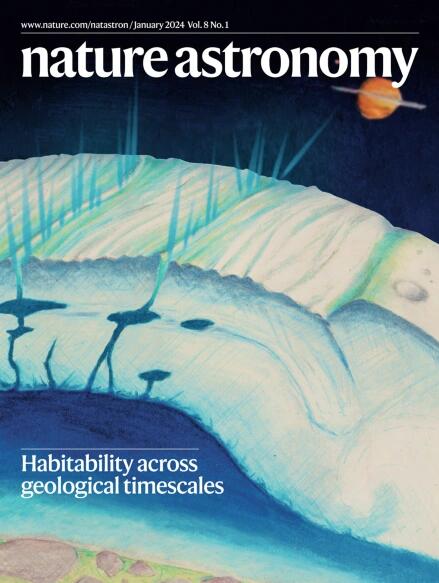银河系状星系中看不见的旋臂
IF 14.3
1区 物理与天体物理
Q1 ASTRONOMY & ASTROPHYSICS
引用次数: 0
摘要
恒星结构和星系的暗物质(DM)晕动态地交织在一起。然而,恒星旋臂对DM光晕形态的影响仍然很少被探索。Marcel Bernet和他的同事通过研究一个类似银河系的星系的DM光晕上的恒星螺旋印记来解决这一缺陷,揭示了黑暗螺旋臂的存在。利用孤立棒旋星系的n体模型,作者发现恒星旋臂和DM旋臂共同演化,表现出强烈的时空相关性。暗螺旋的总质量约为星臂质量的10%。一旦两个螺旋变得足够强大(t≥4.5 Gyr),它们共享一个恒定的模式速度(~20 km s-1 kpc-1),由于对恒星成分演化潜力的延迟响应,DM螺旋不断落后于恒星螺旋。本文章由计算机程序翻译,如有差异,请以英文原文为准。
Invisible spiral arms in Milky Way-like galaxies
求助全文
通过发布文献求助,成功后即可免费获取论文全文。
去求助
来源期刊

Nature Astronomy
Physics and Astronomy-Astronomy and Astrophysics
CiteScore
19.50
自引率
2.80%
发文量
252
期刊介绍:
Nature Astronomy, the oldest science, has played a significant role in the history of Nature. Throughout the years, pioneering discoveries such as the first quasar, exoplanet, and understanding of spiral nebulae have been reported in the journal. With the introduction of Nature Astronomy, the field now receives expanded coverage, welcoming research in astronomy, astrophysics, and planetary science. The primary objective is to encourage closer collaboration among researchers in these related areas.
Similar to other journals under the Nature brand, Nature Astronomy boasts a devoted team of professional editors, ensuring fairness and rigorous peer-review processes. The journal maintains high standards in copy-editing and production, ensuring timely publication and editorial independence.
In addition to original research, Nature Astronomy publishes a wide range of content, including Comments, Reviews, News and Views, Features, and Correspondence. This diverse collection covers various disciplines within astronomy and includes contributions from a diverse range of voices.
 求助内容:
求助内容: 应助结果提醒方式:
应助结果提醒方式:


